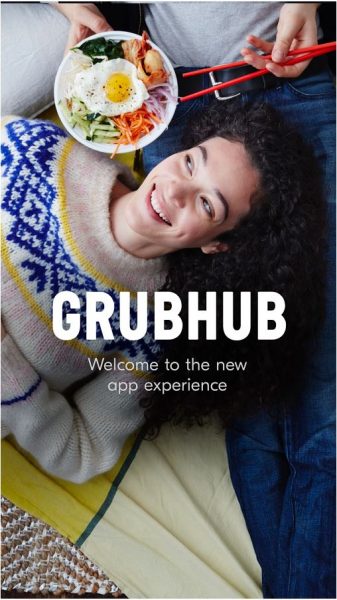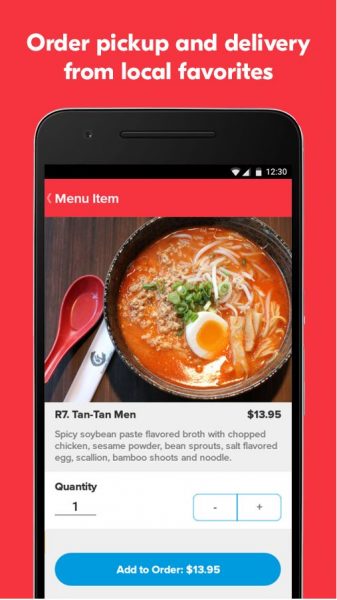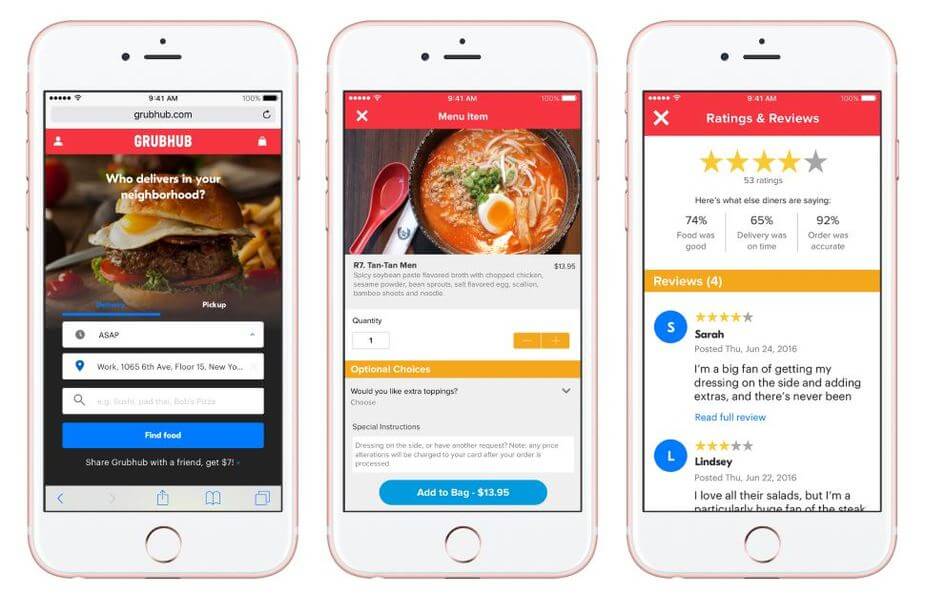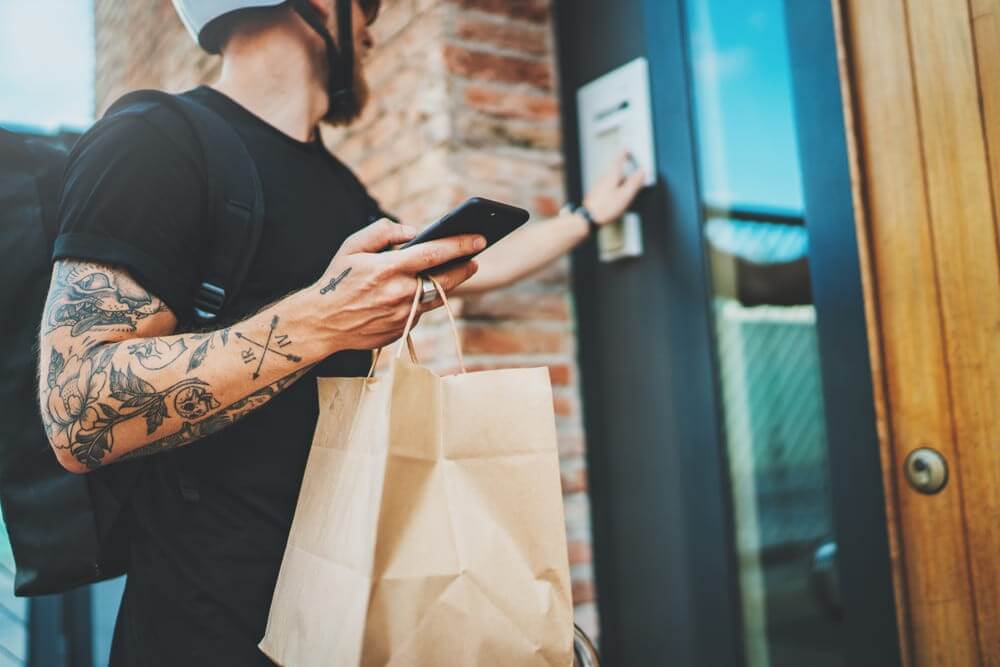The article was updated on February 04, 2021.
Food delivery in 2021 is at its all-time peak. Businesses struggle to cope with the demand generated by the COVID-19 pandemic while inadvertently beating their goals years ahead, and the market growth shows no sign of slowing down. In fact, experts estimate the overall revenue generated by the online food delivery segment to reach $151.5 billion this year. By the end of 2024, this figure is projected to surpass $182 billion.
The largest share of consumers attracted to food delivery apps are those that combine order and delivery services. Platforms like GrubHub help customers receive the meal they want in just a few clicks, minimizing the effort and hassle, as well as social contacts. Although the spike in popularity of online food delivery is attributed to the lockdown restrictions, more and more people have become ready to adopt this approach for good.
If you’re looking to enter this industry, the GrubHub food delivery app is a perfect example to study and determine what makes a delivery application successful. In this article, we’ll take a look at GrubHub’s business model, as well as general challenges and tips on starting your own food delivery business.
The state of food delivery market as exemplified by GrubHub
When talking about food delivery apps, we should first of all differentiate between the services offered by restaurants themselves and third-party providers. In the first case, a bright example of such service is Domino’s Pizza. The restaurant chain dominates the food delivery market with its breakthrough product – AnyWare.
The system allows you to order from Domino’s using almost any device or channel, from Google Home and Amazon’s Echo, to smart TV and connected car. It also integrates with Facebook Messenger, and even can process orders from Twitter.
As for the third-party services, the so-called food delivery aggregators, they seem to be the most popular option. Such apps provide a list of restaurants you can order from. Some of the most popular among them are Delivery.com, DoorDash, Eat24, UberEats, Caviar, and GrubHub.
The latter is probably the most widely used food delivery app, boasting 8.75 million “active diners” (and growing at an annual rate of 26%). Thus, let’s take a closer look at the company and try to define its recipe for success.
Background
Founded back in 2004, GrubHub was among the first to predict the shift in consumer behavior and the rise of the on-demand economy. This allowed the company to win a solid market share of the food delivery industry (GrubHub alone currently holds 23% of the US food delivery market).
As the co-founder, Matt Maloney, told in his interview for Inc.com, the idea came to him and his then co-worker Mike Evans as a solution to their own problem. They were “frustrated by the lack of dinner options as well as the pain in the ass of calling restaurants and reading our credit cards”. Working at a real estate rental company, they decided to apply similar business model to a completely new industry – food delivery.


Initially founded in Chicago, the startup soon scaled to San Francisco where it was able to attract the required attention from the tech-savvy consumers of the Silicon Valley as well from the investors. Another tipping point for the company was the merger with its main competitor, Seamless, that happened in 2013. After that, the company was able to go public at a $3 billion valuation.
Right now the company is the largest food delivery service, partnering with more than 140,000 restaurants across 2,700 US cities. Its mobile app has been topping the ratings as “best food delivery app” for the last decade. But what exactly does it do?
Read also: How to create an MVP for online marketplace?
How does Grubhub work? The business model and tech stack
GrubHub is an on-demand food delivery service, connecting users with the restaurants in their location. Thus, the company’s business model serves two audiences:
1. Restaurants
GrubHub provides restaurants with more orders and helps them improve their efficiency by offering easy, affordable, and reliable delivery services. As a part of its offering for restaurants, the company provides the delivery management software solution.
2. Users
Diners benefit from accessible and simple takeout services provided by the company, a large restaurant selection, and an easy and transparent in-app ordering process. The company also has 24/7 customer service to assist with any claims and questions.
Processes
At the same time, the company doesn’t employ any of its couriers: orders are delivered by independent contractors (similar to Uber drivers).
In order to be able to pay the couriers and stay profitable, GrubHub includes commissions into every order. While the initial idea was to have an annual membership fee for restaurants, the plan didn’t work well. As a result, the company now receives 10% from every order (paid by the restaurants) as well as an additional $2 customer delivery fee.
To run its operations, GrubHub uses a solid tech stack. According to the information listed on the company’s page at StackOverflow, the company’s backend is powered by the following technologies:
- Java/Scala,
- Apache/Spark/Hive, and
- Cassandra / NoSQL /AWS.
The company also uses microservices (Docker) and AngularJS/ReactJS for web frontend development.

Must-have features for a food delivery app
Judging from GrubHub’s success, as well as from a number of startups with a similar business model, there are certain best practices for building a food delivery app. One thing you should consider, though, is that it will take at least 3 products to power a similar business model. Two mobile apps will be facing customers and couriers accordingly, while the restaurants would most likely require a web-based cloud dashboard.
On a side note, you might need some kind of an admin panel for your staff to be able to manage all of the listed products.
So, let’s take a closer look at the scope of functionality each of the listed products require.
Customer app:
- a personal account (payment details, preset delivery addresses, preferences, and order history);
- restaurant search including filters based on location, cuisine, or other aspects;
- a menu for each restaurant;
- accurate GPS capabilities (geofencing required to enable restaurants filtering based on location);
- payments (credit card payments, as well as integration with third-party payment systems, such as PayPal, Stripe, Braintree, ApplePay, etc.);
- order tracking and delivery status, with the ability to contact the driver;
- the ability to leave ratings and reviews for restaurants (and couriers); and
- contact information for customer support.
Courier app:
- a personal account (completed orders, reviews, and preferences);
- the ability to take an order (location-based alerts for orders nearby);
- in-app navigation (integration with Google Maps for accurate routing);
- the ability to change order status in real time (order accepted/rejected, picked up, delivered);
- the ability to contact the customer; and
- the ability to complete the order (and leave a review for a customer).
Restaurant dashboard:
- view order details: the name and location of the customer, the order’s contents, the assigned courier, and delivery status;
- the ability to send notifications to customers and couriers when the order is on the way or ready for a pick-up, respectively;
- menu management: add, delete, and modify items, prices, or descriptions via a convenient interface;
- payment systems integration;
- reports and accounting;
- loyalty programs;
- staff management;
- integration with the existing Point-of-Sale and delivery management solutions; and
- for restaurants working regularly or exclusively with your company, you can offer a custom food delivery service, complete with all the specified features and additional personalization options.
Read also: Restaurant Apps from A to Z: Core Features and Development Tips
As for the internal operations, you should be able to handle customer service, claim resolution, and provide timely support for all of the involved parties, restaurants, customers, and couriers. Thus, you will need a solid customer support solution, integrating with as many communication channels as possible (online chat, email, phone, social media, etc.).

Challenges to consider when building a food delivery app
The main challenge food delivery startups typically face is the need to efficiently balance the operations between all of the involved parties. Your products should work like clockwork to be able to provide reliable support for all of your products, which requires a solid business process optimization and a reliable backend.
So, here are several things to consider:
- Partner only with the trusted restaurants or create your own production so you can have control over every aspect of your business.
- Hire drivers rather than work with independent contractors, or partner with a professional delivery company to ensure the reliability of your service.
- Focus on convenience and the speed of your delivery above all.
- Having excellent customer service is highly important. Remember, you will need to deal not just with angry or irritated customers, but with hungry ones, which is even more dangerous.
One more thing you should remember is that startup burn rate in the food delivery industry is typically very high due to the business model specifics. (Startups like Sprig, for example, are burning through $850,000 a month and are struggling to maintain a profit). Thus, you need to allocate your resources wisely at all times.
Despite the competition and established leadership, the market opportunity for food delivery services is still huge. Namely, several newcomers managed to score some of the largest first funding rounds recently, including $80 million for Swiggy, $32 million for Habit, and $8.5 million for JoyRun (with its unique peer-to-peer delivery model).
As GrubHub’s CEO, Matt Maloney told Forbes, “This is the most exciting time in this industry, maybe the biggest since the invention of delivery food.” Thus, get ready to bet on this new business opportunity by hiring a reliable development partner.
Read also: These Mistakes Will Ruin Your Mobile Startup
6 tips for success on the food delivery market
Now that you are familiar with the key challenges and functionality demands inherent to the industry, it’s time to sum up the success strategy for building food delivery service apps.
1. Conduct market analysis
Profitable food delivery app development hinges on discovering exactly what your potential customers want. If you choose Thai food as your main angle in a city that favors Italian cuisine, you are likely to exhaust your budget before gaining any income.
Research the preferences of consumers in the area that your app will cover. Pay special attention to the kinds of foods that people choose for takeout and delivery most frequently and outline your target audience.
2. Survey the competition
The on-demand food delivery market is overflowing with service providers, and their number has only surged since the COVID-19 pandemic began. To rise above the competition, you need to know what other businesses in this industry offer, learn about their advantages and drawbacks, and design your application to fill the gaps.
You can also try to identify a niche that’s not yet inhabited by other startups, yet which holds potential interest for the customers.
3. Aim to expand your user base
Gaining more users that generate revenue is the ultimate goal of an application. To attract new customers, first, make sure that your local food delivery app functions seamlessly and provides the best quality of service. Test it locally and incorporate modifications and updates depending on user feedback.
You should also target several marketing channels for your app’s promotion. Strive to expand the reach of your campaign by recruiting influencers, restaurants, and retailers into mutually beneficial partnerships—tapping into the audiences of larger companies is a good way to bring your quality services into the spotlight faster.

4. Focus on user retention
To make a consistent profit, your app for food delivery should aim to build a stable user base rather than rely on one-off orders. You should split your retention efforts between the three main groups: customers, couriers, and restaurants.
Customers: impeccable service and customer support constitute the backbone of user retention. You should also consider introducing loyalty programs, discounts for returning clients, and regular special offers.
Couriers: to keep your couriers interested, offer good salaries, performance bonuses, and flexible schedules.
Restaurants: maintaining a stable relationship with your partner restaurants is no less critical than retaining your customers. Keep the communication channels open in case any issues arise. If a restaurant undergoes some significant internal changes, examine your offer and determine whether the value you present is still considerable.
5. Be mindful of your budget
As we have mentioned before, food delivery startups face significant expenses and often struggle to even the expenses and profits. Therefore, it becomes paramount to keep an eye on your budget and take all potential expenses into account before launching the development process.
Consider such details as software development, courier fees, employee salaries, and maintenance costs to discover your limits and subsequently pick the most fitting development stack.
6. Monetize the app
Figuring out how to make a profit from your application is a crucial stage of creating a business plan. Research monetization models of similar apps and choose what fits your style and needs.
The most widespread models include monetization through
- Delivery fees. You can charge restaurants and customers per order.
- Order commissions. Delivery services frequently charge restaurants with a small commission from every order that’s done via the application. Alternatively, you can present restaurants with the option of a paid subscription plan.
- In-app advertising. Restaurants can pay for a better position in your app’s listing since it improves their customer flow. For instance, GrubHub fees include a voluntary 20% commission for restaurants that wish to be displayed at the top of the list in the app. This model can also include ads from third parties that are removable by paid subscriptions.
How to get started?
The product discovery phase is the best first step you can take to lay a solid foundation for the development of your app. It includes a functional specification, UX/UI design, and a visual prototype that will give you a clear vision of the end product. On average, this phase takes 4-6 weeks.
The product discovery phase can help you:
- define a full scope of work and develop a roadmap for the project
- set a realistic budget for your MVP and plan your resources
- test the waters with your audience using a visual prototype
- craft a convincing investment pitch
- get to know your team
We at Eastern Peak have successful experience in building on-demand apps for startups. To find out about our services and get professional advice, contact us now.
Read also:


